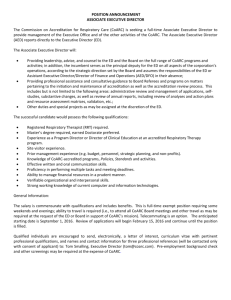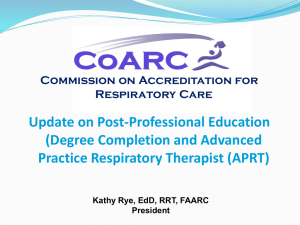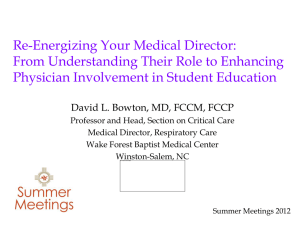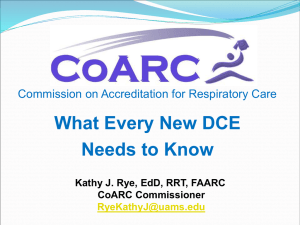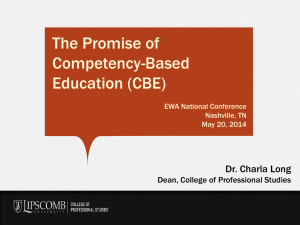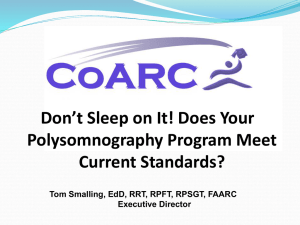inter-professional competence - Committee on Accreditation for
advertisement
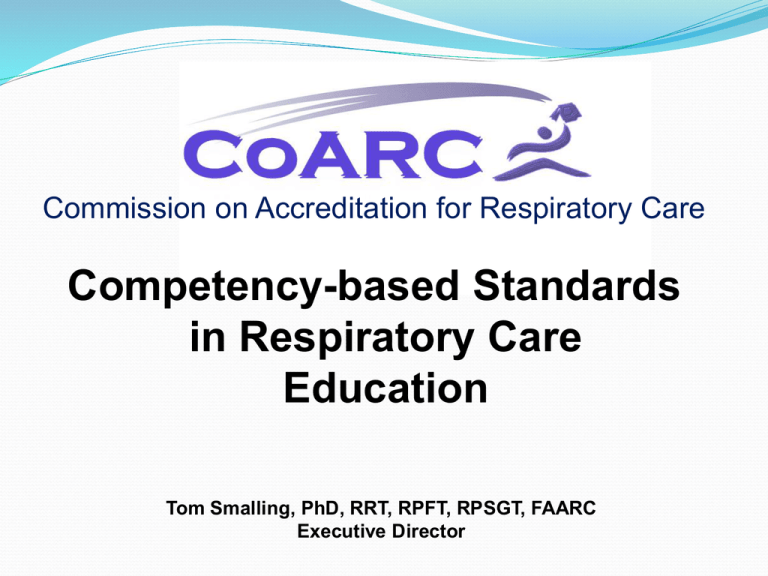
Commission on Accreditation for Respiratory Care Competency-based Standards in Respiratory Care Education Tom Smalling, PhD, RRT, RPFT, RPSGT, FAARC Executive Director Conflict of Interest I have no real or perceived conflict of interest that relates to this presentation. Any use of brand names is not in any way meant to be an endorsement of a specific product, but to merely illustrate a point of emphasis. www.coarc.com Presentation Overview The presenter will describe the concept of competency- based standards and will highlight the process for identifying professional competencies. Attendees will leave with the ability to compare a curriculum based on competencies vs. a curriculum based on tasks. The speaker will explain how competencies are likely to be incorporated into accreditation standards in the future. www.coarc.com What is Competency-Based Education (CBE)? “Habitual and judicious use of communication, knowledge, technical skills, clinical reasoning, emotions, values, and reflection in daily practice for the benefit of the individual and the community being served” (Epstein & Hundert, 2002, p. 226) The “full array of knowledge, skills, attitudes, and other characteristics (KSAOs) for completing a task or course of study or performing a job, rather than simply knowledge alone” (Calhoun, Wrobel, & Finnegan, 2011, p. 152). www.coarc.com What is Competency-Based Education (CBE)? A core competency is “the identified knowledge, ability, or expertise in a specific subject area or skill set that is shared across the health professions” (Institute of Medicine, 2003, p. 24). The term “competency” has also been used to refer to actual performance in a specific job duty or task, and competencies or competency areas are skills considered necessary to perform a specific job or service (Kelly-Thomas, 1998). www.coarc.com What is Competency-Based Education (CBE)? Hubert and Stuart Dreyfus describe a model for skill acquisition that occurs in five stages along a continuum of learning. These stages include (1) novice; (2) advanced beginner; (3) competence; (4) proficiency; (5) expert (Dreyfus & Dreyfus, 1986). At the level of “competence”, a student can think conceptually and execute planned approaches to care based on the standards and rules they have learned (Gunderman, 2009, pp. 324-325). www.coarc.com What is Competency-Based Education (CBE)? The term “student learning outcomes” is often used synonymously with competencies. The Council for Higher Education Accreditation (CHEA) defines student learning outcomes “in terms of the knowledge, skills, and abilities that a student has attained at the end (or as a result) of his or her engagement in a particular set of higher education experiences” (CHEA, 2006, p. 1). www.coarc.com What is Competency-Based Education (CBE)? The central focus of competency based education (CBE) is on student learning outcomes. In the context of accreditation, CBE addresses what graduates are expected to do (e.g., solve problems, communicate effectively, and provide appropriate care) upon completion of their program of study rather than on what they are expected to learn about during the course of their study. By placing emphasis on results rather than processes, CBE provides a substantial shift in what accreditors and other stakeholders look for in judging the effectiveness of educational programs (Gruppen, Mangrulkar, & Colars, 2010). www.coarc.com What is Competency-Based Education (CBE)? Competency-based accreditation standards focus on the requisite competencies needed for entry into a profession, allow flexibility in the curriculum to achieve competencies, and establish criteria to assess achievements and deficiencies by monitoring outcomes. CBE’s emphasis on student performance as evidence for having achieved a competency is predicated on the ability to accurately and validly measure performance in tasks and situations reflective of that competency (Gruppen, Mangrulkar, & Colars, 2010). www.coarc.com Why the Emphasis on Competencies? Increasing shift from a traditional, curriculum-centric approach of defining required courses to an outcomescentric approach that establishes requisite competencies as the primary means to assess the achievement of expected student learning outcomes. Increased demand for allied health professionals who offer a wider range of clinical skills, greater experience in independent practice, more flexibility in adapting to various practice settings, and who are culturally sensitive, teamfocused, and possess interpersonal and listening skills (O' Neil & Pew Health Professions Commission, 1998, p. 47). www.coarc.com Why the Emphasis on Competencies? In what has become a seminal document facilitating the movement to a competency-based approach to education and accreditation, the IOM detailed five core competencies needed across the health professions, expressed through a vision to be shared by all institutions of health professions education: “All health professionals should be educated to deliver patientcentered care as members of an interdisciplinary team, emphasizing evidence-based practice, quality improvement approaches, and informatics” (Institute of Medicine, 2003, p. 3). www.coarc.com Why the Emphasis on Competencies? The IOM also encouraged educational accrediting agencies to expand from an assessment model focused on structure and process to one that includes evaluation of the institutions based on student-centered outcomes (Calhoun, Wrobel, & Finnegan, 2011, p. 15). Specifically, Recommendation #3 called on accreditors to: “move forward expeditiously to revise their standards so that programs are required to demonstrate through process and outcome measures that they educate students in both academic and continuing education programs in how to deliver patient care using a core set of competencies” (Institute of Medicine, 2003, p. 8). www.coarc.com Why the Emphasis on Competencies? With shortages in the health care workforce projected over the next couple of decades coupled with increasing demands by employers for graduates to possess a skillset needed to successfully deal with the health care needs of the 21st century, the Department of Education, under the leadership of Secretary Margaret Spellings, responded in 2006 with further recommendations for transforming the US higher education system that included, among others, that “higher education institutions should measure and report meaningful student learning outcomes.” www.coarc.com CBE Initiatives by other Professions Many US accrediting agencies have responded to the recommendations from the Pew Commission, IOM, CHEA, and DOE by enacting significant changes to their accreditation standards and review processes. Many of these efforts have been driven by the professional organizations themselves, in an attempt to define expected knowledge, skills and behaviors of graduates entering practice (Gruppen, Mangrulkar, & Colars, 2010). www.coarc.com CBE Initiatives by other Professions The accrediting organizations for dentistry, health care management, medicine, nursing, pharmacy, physician assistant, athletic training, health information management, occupational therapy, physical therapy, dietetics, acupuncture and oriental medicine, nuclear medicine technology, and public health currently all require that core and/or specific competencies be achieved as stated in their respective accreditation documents, or alternately require individual programs to develop, implement, and document their own individualized competencies. www.coarc.com CBE Initiatives in Respiratory Care Originally issued in 1998 and later revised in November 2011, the AARC published the position statement, Competency Requirements for the Provision of Respiratory Care Services (www.aarc.org) “All health care practitioners providing respiratory care services to patients, regardless of the care setting and patient demographics, shall successfully complete training and demonstrate initial competence prior to assuming those duties. This training and demonstration of competence shall be required of any health care provider regardless of credential, degree, or license.” www.coarc.com CBE Initiatives in Respiratory Care The AARC also published position statements on ethics and professional conduct as well promoting diversity education and cultural competence (AARC, 2010); AARC 2015 and Beyond Conference 2: upon entry into practice in 2015, a graduate RT and RTs already in the workforce must possess 69 competencies in 7 major domains: (1) diagnostics; (2) disease management; (3) evidence-based medicine and respiratory care protocols; (4) patient assessment; (5) leadership; (6) emergency and critical care; and (7) therapeutics (Barnes, Gale, Kacmarek, & Kageler, 2010, p. 604). www.coarc.com CBE Initiatives by CoARC CoARC defines competencies as the “written statements describing the measureable set of specific knowledge, skills, and affective behaviors expected of graduates” (CoARC, 2010, p. 10). While the 2010 CoARC Standards currently do not mandate a set of core competencies, CoARC does require programs to provide evidence of student learning outcomes (i.e., competencies) as an integral part of its standards and processes for review. www.coarc.com CBE Initiatives by CoARC Specifically, CoARC Standard 4.01 requires that programs “prepare students to meet the recognized competencies for registered respiratory therapists identified in these Standards” (CoARC, 2010, p. 23). Further, Standard 4.02 requires programs to “define and list the competencies it requires for graduation. The program must employ student evaluation methods that measure all defined program competencies. These competencies and evaluation methods must be written and communicated to the enrolled students” (CoARC, 2010, p. 23). www.coarc.com CBE Initiatives by CoARC CoARC Standard 4.08: “Graduates must be competent in interpersonal and communication skills to effectively interact with diverse population groups” (CoARC, 2010, p. 24). CoARC Standard 4.09: “Graduates must be competent in the application of problem solving strategies in the patient care setting” (CoARC, 2010, p. 24). www.coarc.com CBE Initiatives by CoARC CoARC is currently undergoing a Standards revision process this year; CoARC will continue its outcomes-centered approach to the accreditation review process; Given the significant shifts to a competency-based approach to accreditation as discussed in this presentation, revisions to the 2010 Standards will likely reflect an increased emphasis on student learning outcomes that focus on the competencies and attainment levels reached by respiratory care students upon completion of their first professional degree program. www.coarc.com CBE Initiatives by CoARC Possible Core Competency Domains in Future Standards: 1. Respiratory Care Knowledge 2. Interpersonal & Communication Skills 3. Patient Care 4. Professionalism 5. Practice-Based learning and Improvement 6. Systems-based Practice 7. Inter-professional Practice www.coarc.com Inter-professional Competencies Originally defined by the Pew Commission and IOM in the context of “working in interdisciplinary teams”, the term inter-professional competence has gained prominence in recent years as a critical knowledge, skill, and ability required of health care professionals in an ever-increasingly complex health care system. Preparing students to be able to work effectively as members of clinical teams with the goal of providing a safer, patient-centered health care system is a central tenet of inter-professional education. www.coarc.com Inter-professional Competencies Inter-professional competencies are defined as the “integrated enactment of knowledge, skills, and values/attitudes that define working together across the professions, with other health care workers, and with patients, along with families and communities, as appropriate to improve health outcomes in specific care contexts” (IEC Expert Panel, 2011, p. 2). The four core competency domains (and general competency statements) include: www.coarc.com Inter-professional Competencies 1. Values/ethics for inter-professional practice Work with individuals of other professions to maintain a climate of mutual respect and shared values; 2. Roles/responsibilities Use the knowledge of one’s own role and those of other professions to appropriately assess and address the healthcare needs of the patients and populations served; www.coarc.com Inter-professional Competencies 3. Inter-professional communication Communicate with patients, families, communities, and other health professionals in a responsive and responsible manner that supports a team approach to the maintenance of health and the treatment of disease; and 4. Teams and teamwork Apply relationship-building values and the principles of team dynamics to perform effectively in different team roles to plan and deliver patient-/population-centered care that is safe, timely, efficient, effective, and equitable (IEC Expert Panel, 2011, pp. 17-25). www.coarc.com Five things we’ve learned about competency-based education… Federal and state policymakers as well as the public are holding higher education institutions and accreditors accountable for the measurement and reporting of student competencies and programmatic outcomes. A systematically different approach to the design of curricula is needed that provides greater alignment with what society needs from those that are responsible for its health. A competency-based accreditation review process centers on student learning outcomes as the key indicator of institutional quality and performance. CBE guides decisions about what graduates must be able to do, in order to appropriately address healthcare needs and market conditions. CBE uses these expectations to then develop and implement the curriculum designed to produce the requisite knowledge values, and skills in the graduates to achieve these competencies. Programs can continue to improve the quality and adaptability of their graduates through greater use of competency-based education and a greater focus on the performance requirements for graduates entering the profession. Questions / Comments? tom@coarc.com www.coarc.com
